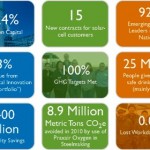
Bangalore, India – On the eve of the launch of Apple’s iPad, a new Greenpeace report reveals how the rise of cloud computing threatens to see greenhouse gas emissions from powering ever expanding data centers spiral out of control.[1]
“Make IT Green: Cloud Computing and its Contribution to Climate Change”, shows how the launch of quintessential cloud computing devices like the Apple iPad, which offer users access to the ‘cloud’ of online services like social networks and video streaming, can contribute to a much larger carbon footprint of the IT sector than previously estimated.
The report builds on previous industry research[2] that shows that at current growth rates, data centers and telecommunication networks, the two key components of the cloud, will consume about 1,963 billion kilowatts hours of electricity in 2020, more than triple their current consumption and almost double than electricity consumption of India.[3] However, the report also shows how IT can avert climate chaos by becoming a transformative force advocating for solutions that increase the use of renewable energy.
India is now considered the new global hub for Cloud Computing. There is massive expansion going on in digital infrastructure like Data-centers & Telecom-towers. According to IDC India, the domestic Data Centre Market is expected to touch US$ 1.52 billion with cumulative data centre built-up area likely to touch nearly 8.4 million square feet[4]. Recently, Tata Communications unveiled its largest Data-center in India located on 55,000 sq.ft. in Pune. Google is also building its new Data-center close to Hyderabad which occupies 20 acres of lands. Many other international and local players are also building their data-centers which are seeing rapid growth in the Indian market at 31% CAGR. Further, numbers of telecom towers are also expanding from the current 2,50,000 to around 4,00,000 in the next three years. The tele-communication sector alone consumes 1.8 billion litres of diesel to run their Base Transmission Towers.
“As digital infrastructure expands, the IT industry’s appetite for energy will increase, making it a major source of climate change unless the industry adopts and advocates renewable energy use and backs laws to cut growing emission,” said Abhishek Pratap, Greenpeace India Cool IT campaigner. “IT companies are now in powerful positions given the huge contribution of this sector to the economy at the national level. They must use that influence to promote policies that will allow them to grow responsibly without helping to fuel climate change.”
Facebook recently announced the construction of its own data center in Prineville, Oregon, running primarily on coal. By choosing energy company PacifiCorp, a utility that sources the majority of its power from coal-fired power stations, Facebook missed a chance to promote the use of renewable energy and instead reinforced the coal industry’s grip on the United Sates power grid.[5]
“The ICT sector has the ability to help us combat climate change by doing what it is best at – innovating to reduce greenhouse gas emissions and increase energy efficiency,” Greenpeace International Campaigner Casey Harrell said. “Technologies that enable smart grids, zero emission buildings and more efficient transport systems are key to cutting climate change pollution. But given the current pace of growth in cloud computing, the industry needs to get its own carbon footprint under control.”[6]
Greenpeace calls on IT industry giants to put their might behind government policies that give priority grid access for renewable sources like wind and solar energy. IT companies should also support economy-wide climate and energy policies around the world that peak emissions by 2015.
Source: Greenpeace Press Release dated April 2, 2010.
Notes:
[1] “Make IT Green: Cloud Computing and its Contribution to Climate Change” is available for download at –
http://www.greenpeace.org/international/press/reports/make-it-green-cloud-computing
[2] The Make IT Green report builds on the seminal analysis of the Smart 2020 Report (2008) which detailed the growing carbon footprint of data centers and telecommunication networks. To make the data of the report more accessible as an instrument to evaluate the projected impact of the cloud on electricity demand and their relationship to energy policies, the Smart 2020 analysis has been de-aggregated to show overall electricity consumption.
The 2020 Report provides carbon footprint figures in MtCO2e as a combination of two sources of emissions: indirect emissions from electricity use (scope 2) and indirect emissions from upstream production (scope 3), or embodied carbon. To show electricity or energy use emissions separately, a correction factor [Scope 2/ (Scope 2+3)] was applied. This correction factor for Scope 2 is derived from the information provided on global internet footprint in the Smart 2020 Report, which includes PCs in addition to telecoms and data centers. The Smart 2020 Report is available at –
http://www.smart2020.org/publications
[3] National electricity consumption data obtained from the United States Central Intelligence Agency World Factbook, 2007 data –
https://www.cia.gov/library/publications/the-world-factbook/rankorder/2042rank.html
[4] Ministry of New & Renewable Energy tender for powering Telecom Tower through Renewable energy –
http://mnes.nic.in/
[5] To challenge Facebook to drop coal and use clean energy, Greenpeace began an advocacy page on Facebook. As of now, more than 3,65,000 people have signed one of the Facebook groups (in English and Spanish) –
http://www.greenpeace.org/coalfacebook
[6] The ICT sector’s abilities to lead and to innovate are the reasons Greenpeace began its Cool IT Campaign in 2009. The campaign uses direct company engagement and public engagement to provide pressure on the ICT industry to put forward solutions to achieve economy-wide greenhouse gas emissions reductions and to be strong advocates for policies that combat climate change and increase the use of renewable energy. For more information visit –
http://www.greenpeace.org/coolit














